88% of B2B companies and 76% of B2C companies are now investing in content marketing. This proves that the market is increasingly mature. However, building an effective content marketing strategy is not that easy and requires specific expertise, that goes beyond editorial. Even if readers are the primary target of the contents published online, it would be a mistake to not consider Google… When 51% of the traffic of a website comes from organic referencing, far more than social networks representing on average only 5%, optimizing your strategy by combining Content Marketing and SEO is, therefore, an essential step to succeed in content strategy. What is the process to follow? How can Semji help in building your strategy, content creation, and performance tracking? In this article, we will share with you what it takes for a great SEO and content marketing strategy.
Why combining SEO and Content Marketing?
By definition, content marketing consists in creating and publishing content that triggers opportunities in order to attract a target audience and to increase customer acquisition. This content can take different forms: blog articles, online guides, e-books, infographics, case studies, landing pages… The main thing is that they provide a useful and relevant response to the needs of online users.
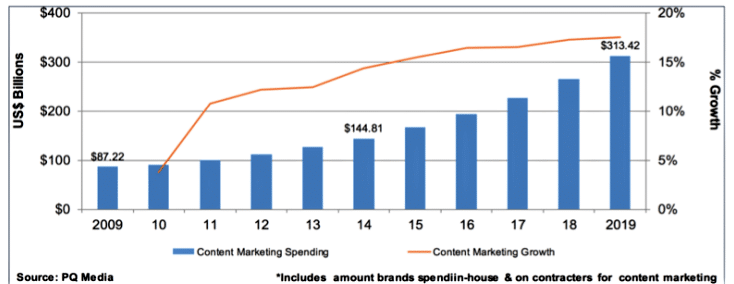
The market has been growing exponentially for the past years (doubled in 5 years), Content Marketing is arousing great interest among companies. This trend will continue to grow over the coming years.
Content marketing could be narrowed down to 3 key steps: create content, attract your audience, convert it into customers.
From experience, it’s usually on the second step, attracting your audience, that the results don’t follow, negatively impacting the whole content marketing strategy. It’s simple, no matter how much content you create, if it doesn’t generate enough traffic, the number of conversions will be limited: the ROI of your content marketing strategy will be too low.
In short, you want to avoid this SEO traffic curve for each of your contents:
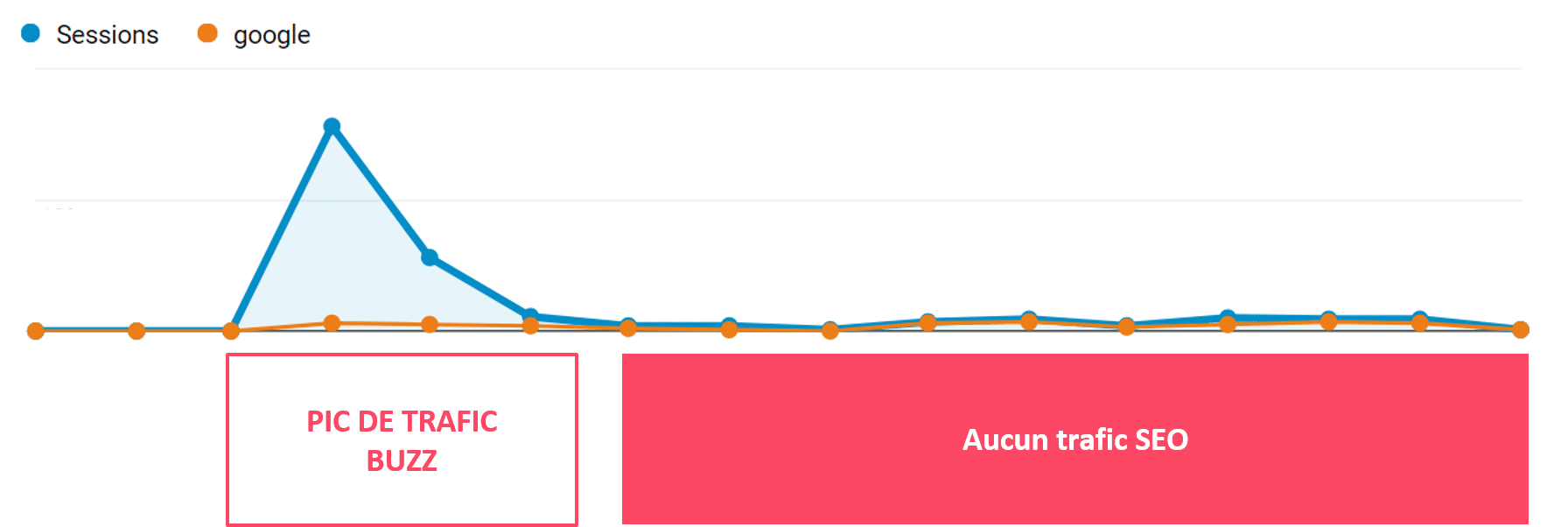
Ever heard of the “Fluzz” curve? It’s a mix of “Buzz” and “Flop” (see the graph above). After posting new content on your website (e.g. an article on your blog), you will usually share it on social networks and other media. At this precise moment, your article will probably “buzz”, the marketing team will even congratulate itself on the number of shares on social networks. Unfortunately, in many cases, the curve will quickly “Flop” and your article will not generate any more visits. This is typically the kind of traffic curve that an SEO agency or consultant would like to avoid for their clients because the return on investment is too low.
When you publish new content, this is the traffic curve you want to get:
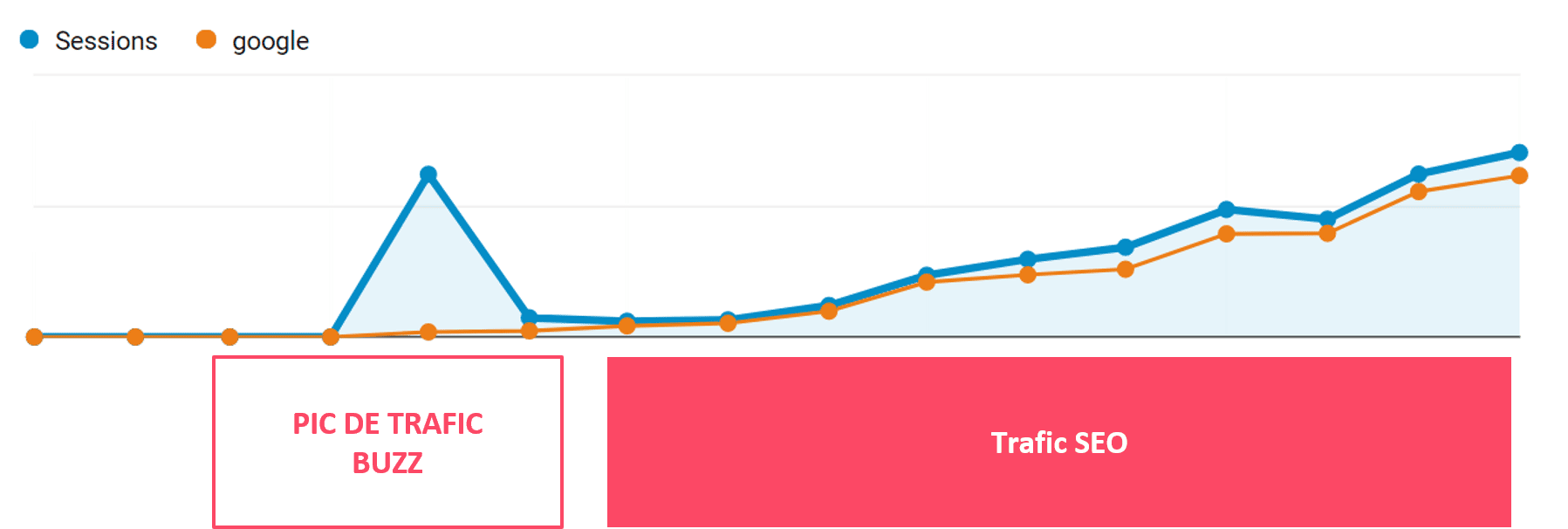
This is exactly the type of traffic curve you want to get for your content marketing strategy! After the peak of the buzzing traffic, mainly because your content is being shared on social networks, the curve evolves positively thanks to the SEO optimizations made beforehand. On the visual above, the orange curve represents the organic traffic curve, which becomes the most important acquisition channel. Here, the return on investment is much more interesting: by regularly publishing articles with this type of performance, your website will exponentially increase its traffic.
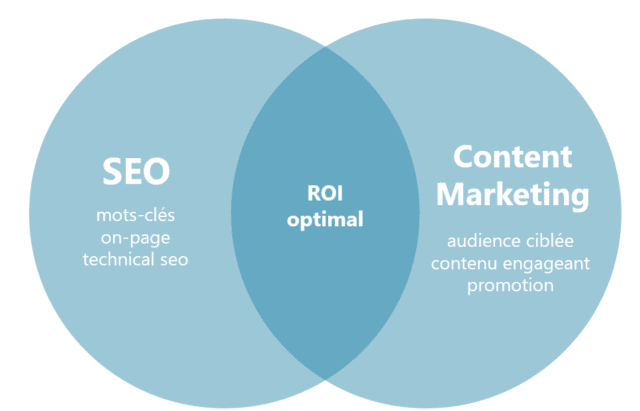
Content Marketing and SEO: the recipe for high-performing content!
To generate traffic in a sustainable way, it is essential to implement good SEO practices within each key step of the content marketing cycle. In short, you have to stop making a difference between SEO and content as they are complementary!
While SEO is more technical (Google expertise, keywords, on-page optimization, technical SEO…), Content Marketing is about relevant editorial techniques to attract readers (target your audience, create engaging content, promote it on social networks or paid channels…). Semji is a comprehensive tool to optimize your content’s performance and will help you implement the best SEO practices to achieve your content marketing targets.
A successful content marketing strategy is based on the following elements:
- Define your Buyer Persona (typical profile of your target customers)
- Identify your audience’s topics of interest
- Create optimal content
- Post it
- Promote it to attract your audience
- Analyze the results
- Improve the content based on results
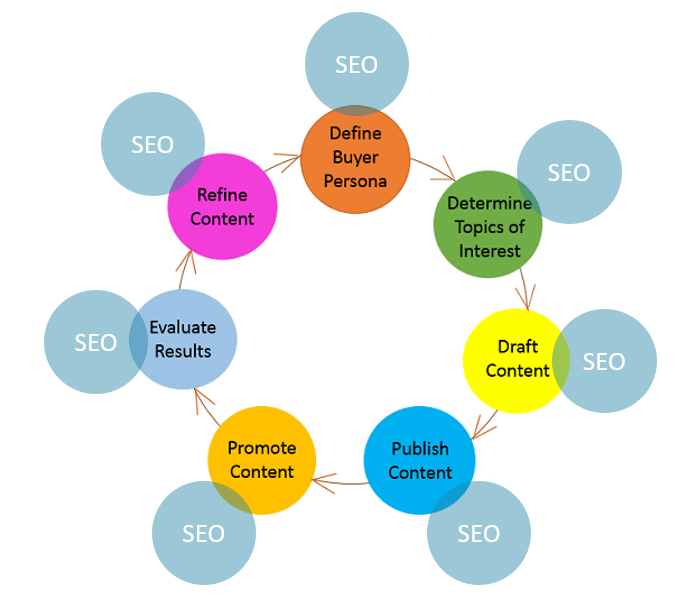
Top 7 best practices in SEO Content Marketing
Now that you have a better idea of what SEO content marketing is, let’s focus on the top 7 SEO best practices for an efficient content strategy!
1/ Define an editorial with strong SEO potential
The editorial line is the cornerstone of a content marketing strategy, especially when creating blog posts. Let’s take the example of the blog of an e-commerce website selling electric bikes. To maximize the performance of our Content Marketing strategy, we will ask ourselves the following question for each new content: what are the targeted SEO keywords? After a semantic analysis, we will define the topics of blog articles that will allow us to target all our strategic keywords, in order to capture qualified SEO traffic.
The semantic analysis: an essential step in creating your editorial line.
To carry out a semantic analysis, the first step consists of analyzing the keywords with specific tools and identifying the most frequent questions about the subject, in our example, electric bikes. Thanks to this semantic analysis, we can define the priority keywords for our business, based on their search volume (quantitative aspect) and their conversion potential (qualitative aspect).
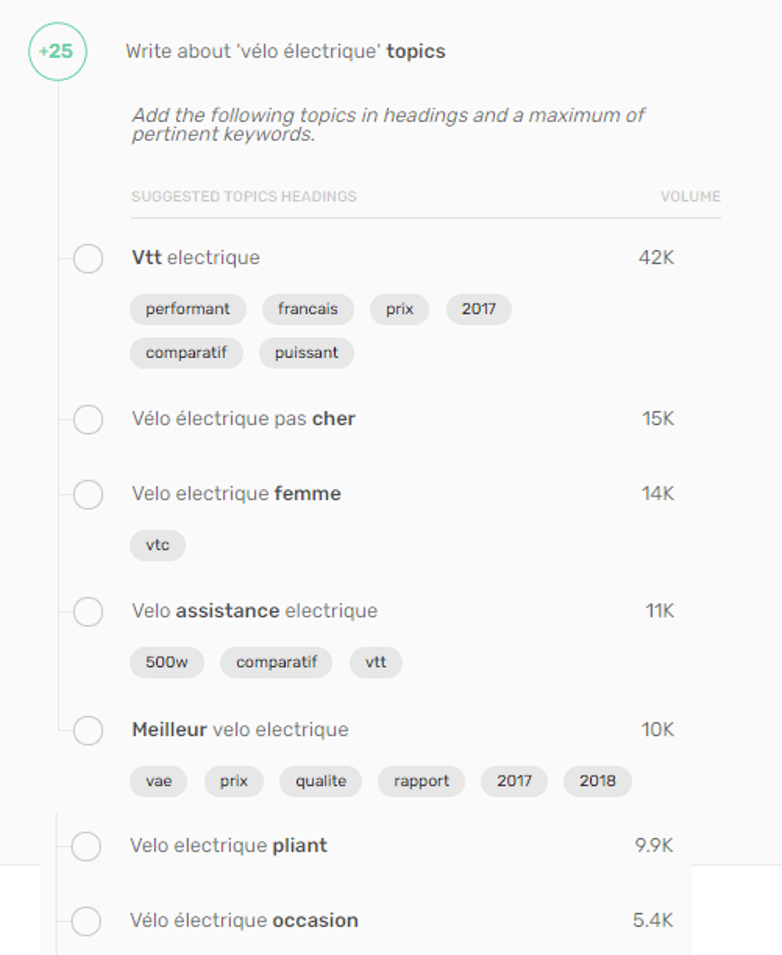
A generic keyword is a keyword with a high search volume, and where the conversion potential is high. Semji provides you with guidelines for conducting this semantic analysis that will allow you to discover and define the keywords that generate a high volume of searches and on which you should strategically position yourself.
In the screenshot above, Semji suggests that we prioritize keywords like “electric mountain bike” (42,000 monthly searches) or “electric bike for women” (14,000 monthly searches). These suggestions can also give us an idea of the main editorial lines related to our industry (comparative guide of electric bikes, folding electric bikes, used electric bikes…).
Questions keywords should also be targeted.
Internet users are increasingly using voice search to ask questions directly to Google. By analyzing these questions, we will find out more about our Buyer Persona and the answers we need to provide. Then, we will use them as keywords for our editorial line.
Another interesting point is to answer those questions that most often start with the words “how”, “what”, “when”, “what”. Indeed, creating specific content increases your chances to make your website appear in Google’s “zero” position. This position is above the organic results and can often be a Featured Snippet. This is where Semji comes in. Depending on the keywords targeted, Semji delivers a detailed study and provides the questions of your audience and the related traffic volumes.
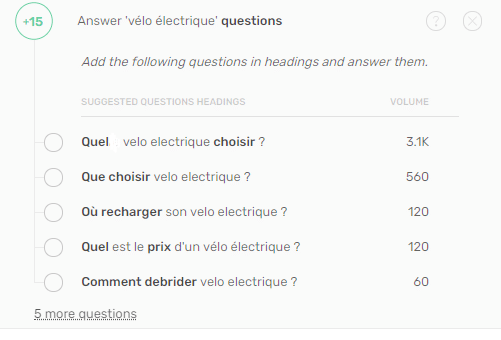
Once the study of keywords and questions is done, the second step to optimize the SEO potential of your editorial line is to group keywords by cluster (groups of close keywords) in order to define the topics of your future content.
Depending on the keywords you are working on, Semji will inform you of the topics to address versus the volume of traffic generated to improve the visibility of your content. For example, by focusing on the keyword “electric bike”, Semji suggests the following topics: “electric mountain bike”, “cheap electric bike”, “women electric bike”, “electric bike”, “best electric bike”. Then, you have everything you need to create your first article topic: ” Electric bikes: the comparative guide. ». From then on, the goal is to add these keywords in the headings of your webpages as well as throughout your article in order to boost its SEO performance.
2/ Define the optimal length for each type of content
The objective is to stand out from your competitors and reach the first position on Google, especially by creating longer content. The most interesting point is that the longer an article is, the more backlinks it gets, thus allowing your entire website to improve its SEO authority. How do you define the optimal length for each content? Semji is here to guide you, by analyzing the first result of the Google SERP and providing you information on the minimum number of words you need to reach and exceed for your own content.

3/ Less is more: post less but better
Content marketing is expensive and time-consuming. The idea is simple: prioritize quality over quantity. It’s better to write 2 or 3 excellent articles of more than 1,000 words that will capture SEO traffic, rather than writing 5 or 6 mediocre articles of less than 500 words that will not get any results.
Semji’s Competitor tab
If you want to set up a successful content marketing strategy, it is essential to answer this question: How is the content of my competitors designed to be in the top positions? The other question is how can I create THE best content? The Competitor tab is here to help you meet this challenge. In the blink of an eye, Semji analyzes your target keyword and reveals the content structure and topics of your top competitors on the SERP.
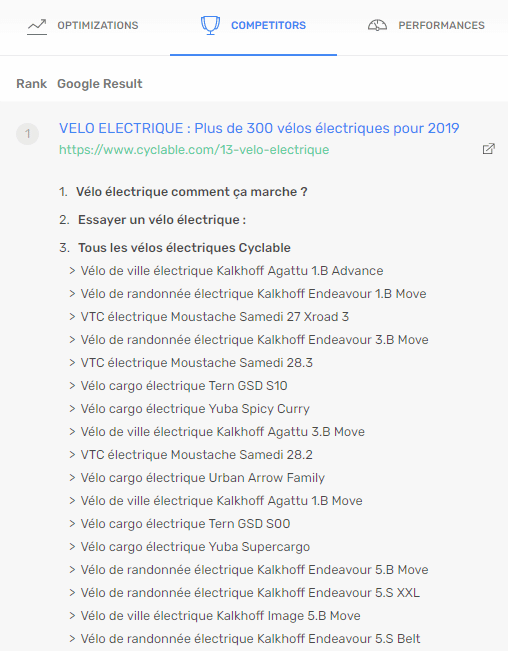
In the above screenshot, we can see what the structure of the #1 competing article is on a given keyword.
With Semji’s help, here are the top questions to ask yourself to outperform your competitors:
- What is the length of my competitors’ contents?
- What editorial line have they chosen to meet users’ needs
- How did they title their content to attract users?
- What visuals do they use in their content?
Now is time to plan and create your editorial calendar.
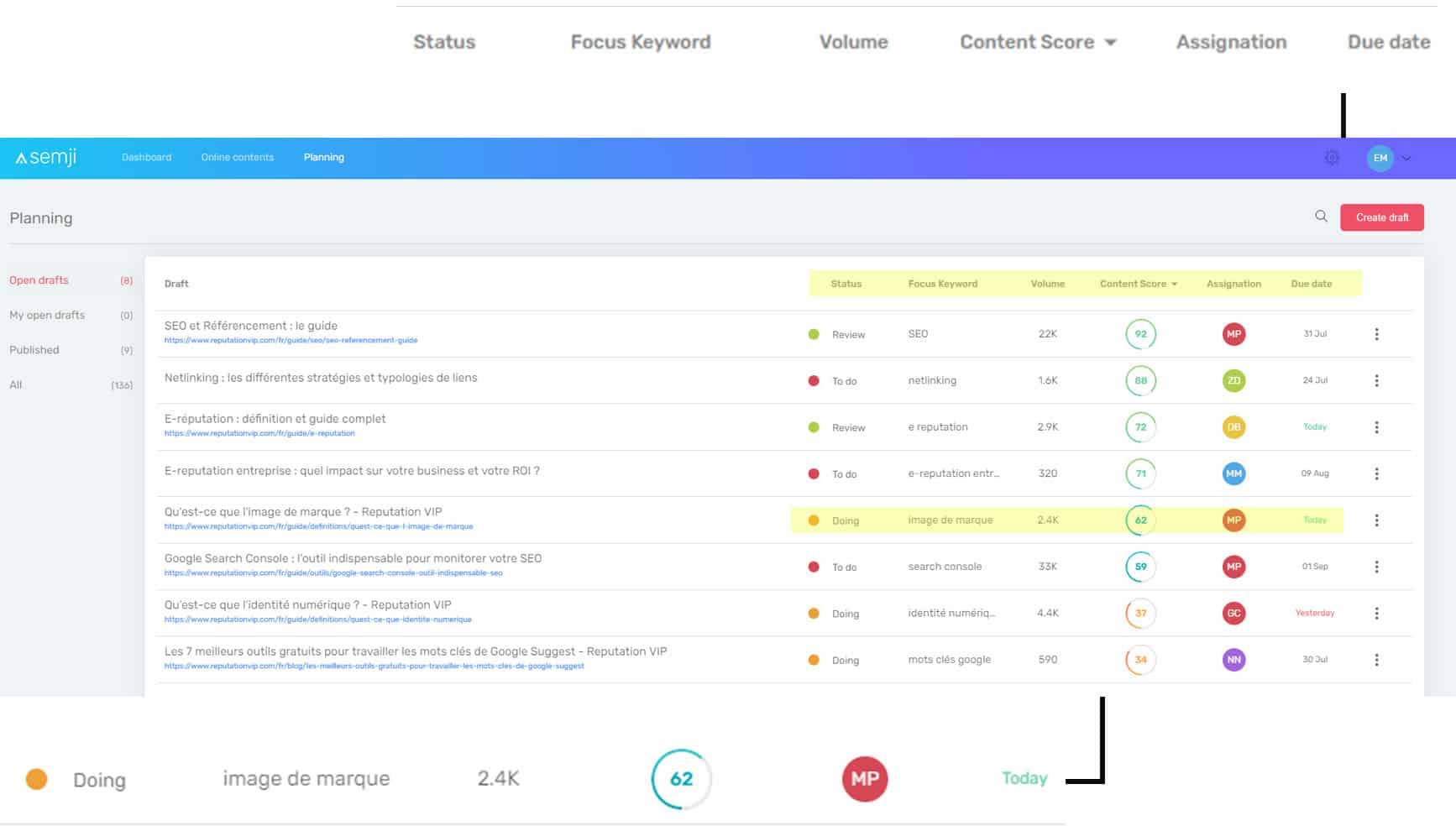
Once all these steps are done, you will have to create your editorial calendar. In a few clicks, you can import all your target keywords into Semji on which you want to position yourself. Once the drafts have been generated, Semji lists in the schedule screen the content that has been created, giving you a global view of your editorial calendar. All you have to do is set the priority level for each of your drafts, assign a writer and set a deadline for each article to be written.
If you are working with an external writer that does not have access to Semji, you can export in a few clicks the Semji study as an Excel file and share with them the recommendations to follow to optimize your content’s performance.
4/ Position content on as many keywords as possible
A piece of content is not positioned on a single keyword, but on hundreds, sometimes thousands. To boost your SEO traffic you need to use as many keywords as possible in your content.
To do this, Semji suggests dealing with topics related to your keyword. This allows you to work on a keyword’s entire semantic environment. The more keywords recommended by Semji you add to your content the more its Content Score increases and the more you optimize its SEO performance. It’s also a true time-saver, as you don’t need to manually crawl your competitor’s pages in order to analyze their semantics to create your own!
5/ Avoid Duplicate Content
Duplicate content can reduce the efficiency of your content marketing strategy. Google has tremendously evolved on the issue in the last few years, it knows how to identify similar texts and even semantic concepts.
If a piece of content has too much duplicated content, it may poorly perform in terms of search engine visibility. Tools such as Copyscape (check for content or URLs) or Siteliner (check all the content of a website) can help you check for external and internal duplicate content. It is highly recommended to use them to optimize your SEO content marketing strategy. If a piece of content has a high rate of duplicate content, it is necessary to rewrite the duplicated part to make it unique, in order to optimize its chances of being well-positioned by search engines.
6/ Optimize your internal linking
In SEO, links created between different contents through internal links are as important as having external links but are much simpler to implement. The goal is to create links from one page to another on your website so that users “consume” as much content as possible, and for these pages to increase their SEO authority for Google. Our content is already created, so we might as well make it as profitable as possible.
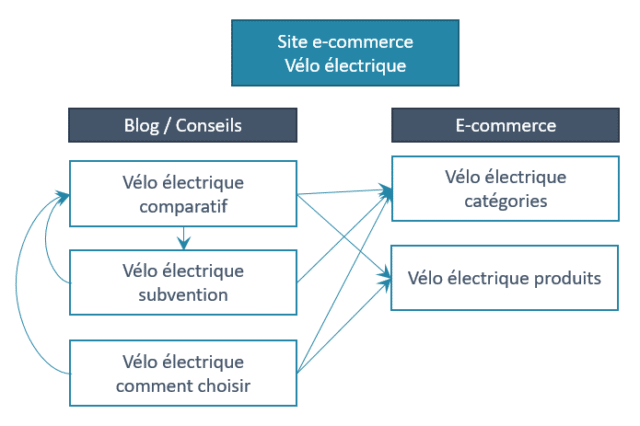
For example, we will link to our “electric bike comparison” article from the “how to choose an electric bike” or “electric bike subsidies” pages, and link them to the e-commerce categories and products mentioned in the article so that these strategic pages gain both SEO visibility and visits from web users already on the website, and ultimately promote conversion. With Semji, this step becomes easier and faster. The platform ensures optimal internal linking by using the most relevant links of your website – as identified during the analysis – to optimize your content.
7/ Monitor your content’s performance
In any strategy, analyzing the performance of your actions and learning from them is essential to improve and aim for the best performance. The same is true in content marketing, yet too much content is created without any real performance monitoring. The risk? Losing money without even knowing it. Neglecting performance tracking means neglecting your ROI.
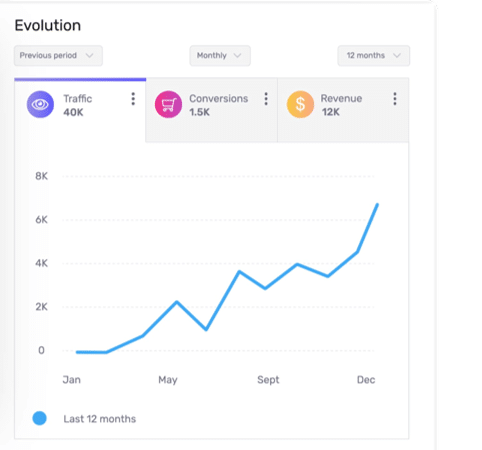
Thanks to Semji’s centralized data system, you have access to global and detailed performance monitoring for every content. The dashboard allows you to follow the general performance of your website according to the KPIs and time ranges selected to compare: traffic, conversions, revenue, impressions… The Performance tab allows you to display content-specific metrics for content created on Semji and shared on your website.
As a web marketing professional, you need to be precise in analyzing the impact of your content marketing strategy and justify the efforts made in producing SEO content. The Report screen displays the statistics of the content worked on according to Semji’s analysis and shared on your site. Two types of views are available: one for the content already existing on your website and optimized in Semji, another one for newly created content. By setting the statistics and periods of your choice, you get a global graph of the performance of the optimized and/or created content, but also detailed results thanks to the micrographs and performance indicators for each of your posts (traffic trend over a given period, monthly traffic, earnings, Semji Content Score…). Your efforts towards SEO content production are finally trackable. You can build and grow your content marketing strategy on clear and sane foundations.
Conclusion
Content marketing has become one of the most popular techniques for attracting new customers online: you are now ready to create an efficient strategy using SEO and Semji. But don’t forget to ask yourself the right questions: Is my content relevant to my Buyer Personas? Is it optimized to capture as much traffic as possible? Is it profitable? If you want to succeed in your content strategy and reach your objectives faster, request a demo with Semji today or download our white paper!
